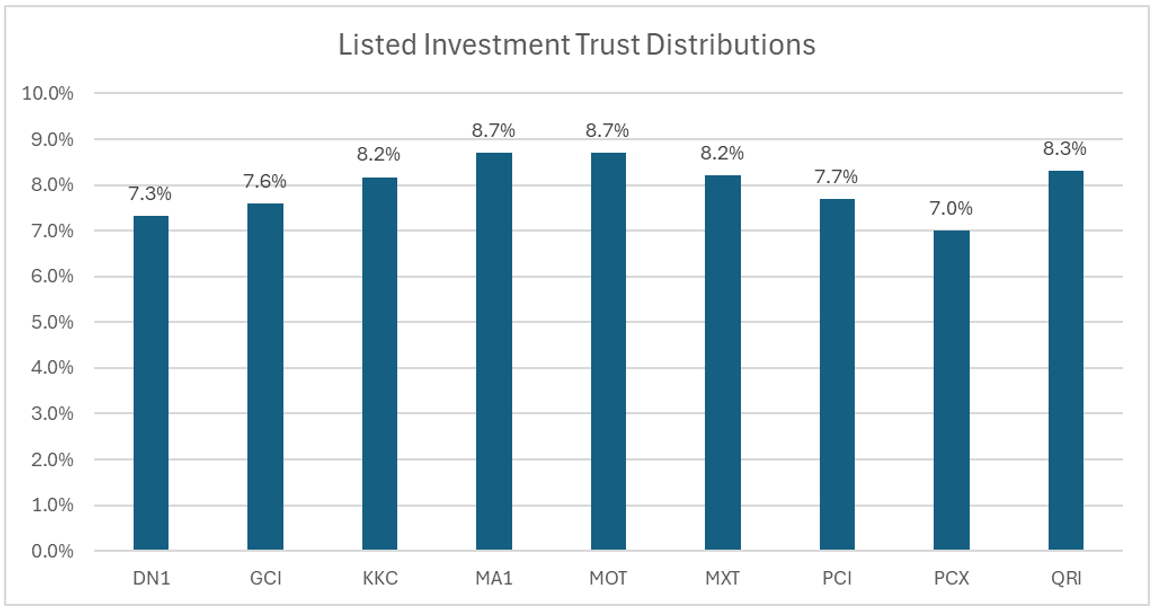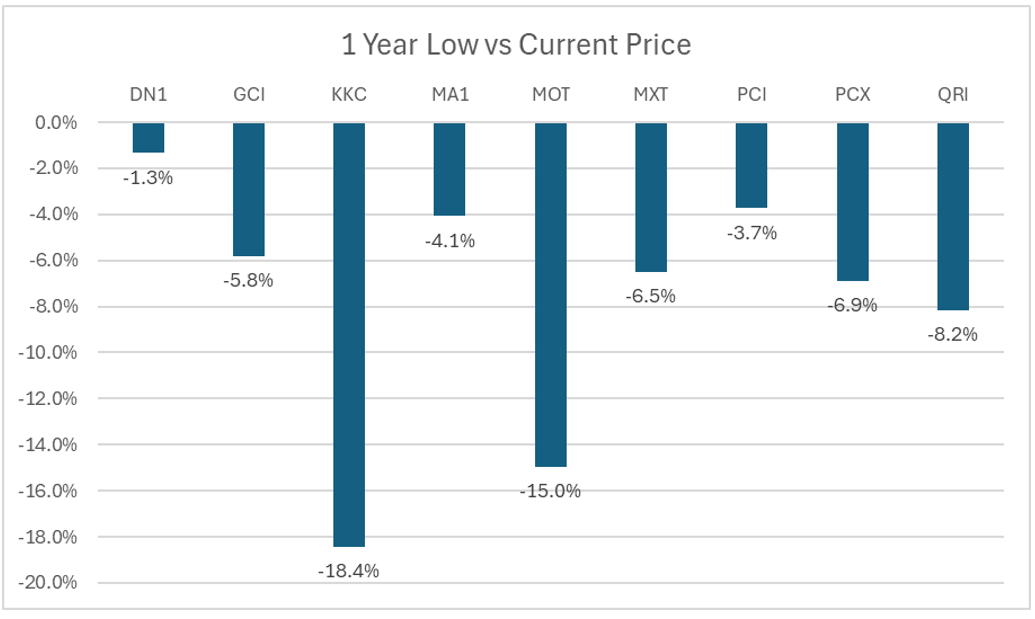Have ASX-listed debt LITs delivered on their promises?
Introduction
Over the past five years, fixed income LITs have become increasingly popular, offering reliable income and exposure to quality credit managers. On income delivery, they’ve largely met or exceeded expectations. Yields have averaged 7–9% in the past year - well above the cash rate. NTA preservation has also been solid, though most funds remain untested by a full credit cycle or recession. The biggest challenge continues to be share price fluctuations, which can materially impact total returns. These often arise from market volatility. While manager communication and reporting have improved, price volatility remains a reality.
Overall, these LITs are delivering - but investors need to stay engaged, understand the risks, and avoid knee-jerk reactions to price moves if they want to capture the long-term benefits.
Assessing the LIT market
Over the past five years, we have seen an explosion in fixed income-focused listed investment trusts (LITs). These structures have become a staple of the ASX, promising reliable income, portfolio diversification, and access to high-quality credit and fixed income investment teams. The vehicles have attracted substantial interest - particularly from retail investors and their advisors.
Now, with a reasonable period in which to evaluate their performance, it’s a good time to ask: Have these debt LITs delivered?
We reviewed nine major ASX-listed fixed income LITs to assess their performance relative to their objectives. Here’s the list. They range in size from $170 million (PCX) and $2.5 billion (MXT).
Scroll right for full information
|
ASX Code |
Name |
Manager |
Primary Investment Focus |
|
Dominion Income 1 |
Realm |
Diversified mix of bonds, loans, |
|
|
Gryphon Capital |
Gryphon |
RMBS/ABS and structured credit |
|
|
KKR |
KKR |
Global private |
|
|
MA Credit Income |
MA Financial |
Diversified, including private credit |
|
|
Metrics |
Metrics |
Sub-investment grade credit |
|
|
MCP |
Metrics |
Investment grade |
|
|
Perpetual |
Perpetual |
Investment grade corporate credit |
|
|
Pengana Global |
Pengana |
Global private credit |
|
|
Qualitas |
Qualitas |
Commercial real estate debt |
For the purposes of this analysis, we have excluded some of the smaller debt-focused vehicles and blended debt/equity vehicles such as MRE and the recent addition WMX.
Income: Good
Let’s start with what has worked. Across the board, income delivery has been impressive. Most funds have yielded between 7% and 9% over the past 12 months.

Most LITs are delivering income yields at a premium of 3-5% above the RBA cash rate.
Income targets for individual LITs have been met, and in many cases exceeded. This is a major positive for investors relying on these vehicles as yield alternatives in a diversified portfolio.
It's worth noting that for most of these LITs, income is linked to variable rates, though sometimes with a lag. If we see several interest rate reductions in the coming year, as is currently expected, it is likely that yields for LITs will reduce.
NTA Preservation: Mostly Good
Despite rate volatility, most LITs have managed to preserve capital relatively well. NTA stability is generally high. When assessing NTA stability, it’s useful to understand what each LIT has invested in, as this can have a big impact on NTA stability. Private credit LITs such as MXT and MOT will have much lower variability in NTA. Others, such as KKC, which invests in publicly traded high-yield and sub-investment-grade credit, will have much more variation in reported NTA.
While NTA variability is one measure of risk, what matters over time is whether the manager sustains any substantial capital losses.
It is worth noting that these managers haven’t been fully tested by a cyclical downturn in the past five years. While performance has held up during the interest rate volatility of 2022, none of these funds have operated through a full-blown credit crunch or a deep recession. We do rate the majority of this manager group very highly, but they really only get tested over a full investment cycle, and we haven’t yet had one. Some areas, such as high-yield credit and offshore assets, we would rate as much riskier in a recessionary environment.
We are not sure the current returns being paid from those assets accurately reflect the risk being borne by investors.
There is one more area to discuss. While NTA has held up reasonably well across these LITs, it doesn’t always translate to share price stability.
Discounts to NTA: The Persistent Risk
One of the main gripes with the structure of LITs has always been their susceptibility to trading at discounts. And while these fixed income LITs have fared far better than the rest of the LIC universe in recent years, it’s still fair to say the results are mixed. Here is the data.

Source: ASX. Data to 15 July 2025. Excludes DN1 and MA1, which have been listed < 1 year.
The sample above can roughly be sorted into three groups.
- Status quo: Total returns for GCI, KKC, PCX and QRI have not varied too much from their distribution yields over the past 12 months. This means the discount or premium to NTA has stayed relatively static.
- Positive contribution: PCI trades at a premium to net asset value, and this premium has increased from one year ago, thus providing about a 5% boost to total returns. But PCI is currently trading at a 7-8% premium to NTA, and if that were to reverse, the opposite would occur.
- Negative contribution: Both MXT (to a small extent) and MOT have seen negative contributions from the share price in the past 12 months. In the case of MOT, that has completely offset the distribution income, meaning total returns near zero for the past year.
The lesson here is that investors in LITs must be prepared to stomach some price volatility.
While an LIT manager may do an excellent job of preserving capital and delivering good income over the long term, if you are prone to selling out if the share price falls by 5-10%, your returns may be quite different. To give some idea of price volatility, let’s take a closer look at the last 12 months. We have measured how far the 52-week low is below the current trading price for each LIT.

Source: ASX. Data to 15 July 2025.
So, in the last year, the LITs have traded between 1.3% (for DN1) and 18.4% (KKC) below their current prices. Why did this occur? A few reasons:
- When markets get upset, as they did in April this year, LITs tend to fall in value. Even though they’re not necessarily directly impacted, prices will fall as with most listed investments, as investors chase liquidity and fear uncertainty.
- LITs investing in publicly traded debt such as KKC can be more impacted by market events, as they mark their investments to market and NTA reduces, at least temporarily. Others, such as MXT/QRI, which hold private credit and PCI, which owns investment-grade credit, will tend to be less impacted.
- We have recently seen some negative press around private credit investments, and criticism of valuation policies for this asset class, something the regulator is currently looking closely at. This can impact LITs such as MXT, MOT and QRI, which invest mostly in private assets.
In general, we believe the LITs are doing a respectable job of managing price volatility. When it comes to communication, most managers do a reasonable job – though there is always some room to improve. Monthly updates are standard, and most provide detailed breakdowns of portfolio holdings and risk metrics. Some funds do well in highlighting loan types, borrower credit quality, and duration risks. Others tend to lump everything into aggregated performance numbers with limited context. Clarity counts - especially when the underlying assets aren’t listed or easy to value.
Various different buyback mechanisms, including some innovative features used by recently listed vehicles, have also helped to limit price fluctuations. We welcome the recent improvements in this area – something that the equity-focused LICs could definitely take on board.
Nonetheless, investors relying on LITs for income need to factor in these potential price gaps and the psychological impact they might have on them.
Our Verdict: Mostly Delivering, With Caveats
As income-producing assets, these LITs have largely delivered on their promises. The manager set is very capable. Fees, for the most part, are fair. Income returns have been in line with expectations.
Buyback mechanisms and relatively stable NTAs are helpful, and manager reporting is reasonably good. But that doesn’t stop the odd market tantrum or other event from hurting the share prices, even if it’s mostly temporary.
For investors who understand the structure - and are prepared for occasional price dislocations - LITs can be a valuable portfolio tool. But they’re not "set and forget". Monitoring discount levels, manager updates, and credit exposure trends is key to ensuring these investments continue to pull their weight.
Before you invest, read this!
We encourage you to do your own research or consult your financial advisor before making any investment. Remember, a great LIT and a great manager are only part of the story. We also like to make sure they are trading at the right price and that the assets they are investing in are not themselves overvalued. We explain how we do this in our LIC Guide, but in the end, it’s up to you to make the investment decision that’s right for you, in conjunction with your financial advisor if you have one.
Take care and all the best with your investing.
Disclaimer: This article is prepared by Affluence Funds Management Limited ABN 68 604 406 297 AFS licence no. 475940 (Affluence) to enable investors in Affluence Funds to understand the underlying investments of the funds in more detail. It is not an investment recommendation. Prospective investors are not to construe the contents of this article as tax, legal or investment advice. Neither the information nor any opinion expressed constitutes an offer by Affluence, its subsidiaries, associates or any of their respective officers, employees, agents or advisers to buy or sell any financial products nor the provision of any financial product advice or service. The content has been prepared without considering your objectives, financial situation or needs. In deciding whether to acquire or continue to hold an investment in any financial product, you should consider the relevant disclosure documents for that product which are available from the product provider. Affluence recommends you consult your professional adviser to determine whether a financial product meets your objectives, financial situation or needs before making any decision to invest.
5 topics
9 stocks mentioned
7 funds mentioned


